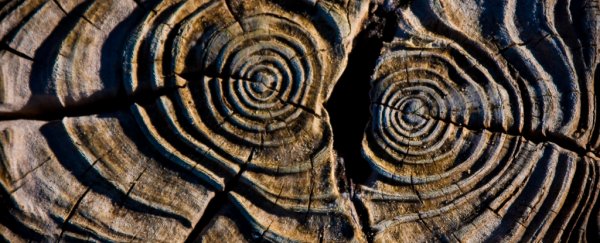Thousands of years ago, on what is now the Greek island of Santorini, a mountain exploded in one of the largest volcanic eruptions in recorded history. But scientists have had difficulty establishing exactly when the Minoan volcano Thera erupted - until now.
An unusual source may be able to settle the debate from conflicting archaeological and radiocarbon analyses: the rings in trees that were alive at the time of the eruption.
Pinning down the date of Thera's eruption could tell us more about not just the event itself, but the Mediterranean, the Middle East, and Egypt at this critical time.
"The volcano erupts and represents one short moment in time, if you can date precisely when that moment is," explained dendrochronologist Charlotte Pearson of the University of Arizona.
"Then, whenever you find evidence of that moment at any archaeological site, you suddenly have a very precise marker point in time - and that's really powerful for examining human/environmental interactions around that time period."
Now researchers have something akin to that marker. According to tree ring data, the eruption of Thera can be placed in the 16th century BCE - sometime between 1600 and 1525, around 3,600 years ago.
It's not a super-precise date, but it does help narrow it down, because radiocarbon dating has placed it as early as between 1650 and 1600 BCE, while archaeological evidence has placed it between 1570 and 1500 BCE.
The research team analysed 285 tree samples from between 1700 BCE and 1500 BCE. But you might be surprised to learn these trees did not come from Minoa, or even the Mediterranean.
Two hundred of the samples came from long-lived bristlecone pines that were growing in California and Nevada during the specified timeframe. The remaining 85 were from Irish oak trees from the same time.
Both of these types of trees are excellent sources for studying the past, because they lay down a single ring every year.
The radiocarbon-14 in those individual rings decays at a steady rate, which means - based on a the current radiocarbon calibration curve that's been developed over the last 50 years - a dendrochronologist can accurately date each ring.
"Every tree ring is a time capsule of the radiocarbon at the year in which it grew, so we can say here's a tree ring from 1600 BC and here's how much radiocarbon is in it," Pearson said.
The second part of the research was to study the actual size of the rings themselves.
Thera's eruption was massive. It buried the Minoan settlement of Akrotiri under a layer of ash and pumice over 40 metres (130 feet) deep. And it spewed dense smoke and material high into the atmosphere.
Remember the eruption of Eyjafjallajökull in 2010? The thick clouds of ash it sent into the atmosphere got into the jet stream, disrupting air travel all over Europe for weeks.
A volcanic eruption as large as Thera would probably have caused a temporary cooling effect, as small particles of ash blocked the light of the Sun; such clouds can stay in the atmosphere for months. In addition, if the volcano emitted sulphur dioxide, this could have reached the stratosphere, combining with water particles to form sulphuric acid aerosols that also block solar radiation.
If this cooling reached both Ireland and the US, evidence would be visible in the tree rings - and it was. During cooler years, both species of tree produce a thinner ring. The researchers found four exceptionally narrow rings during the timeframe that could indicate a massive volcanic eruption.
They also discovered that the old radiocarbon calibration curve wasn't precisely correct for this period - resulting in a more accurate dataset for future researchers.
"This research is about Thera, but really, the implications of it are profound for anyone that uses radiocarbon dating throughout the world for this time span," said one of the team, anthropologist Gregory Hodgins of the University of Arizona.
"There's a kind of revolution in the radiocarbon community to revise the calibration curve using these more precise measurements."
The research has been published in the journal Science Advances.
